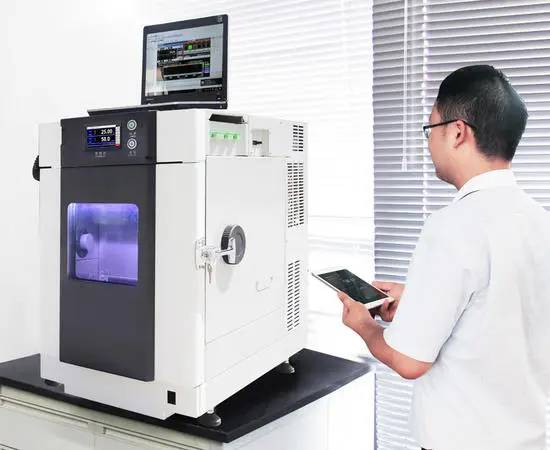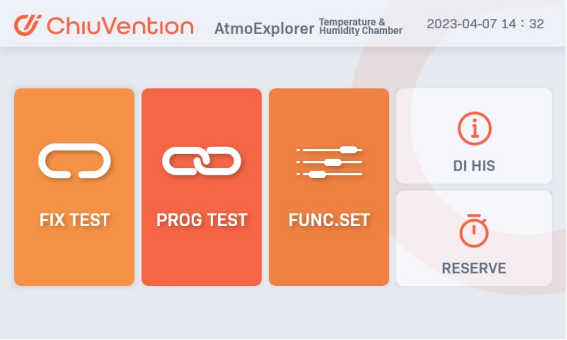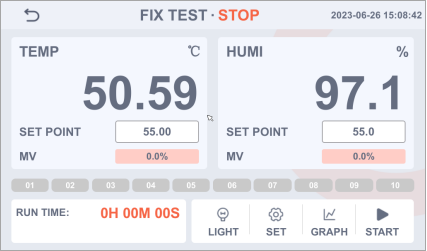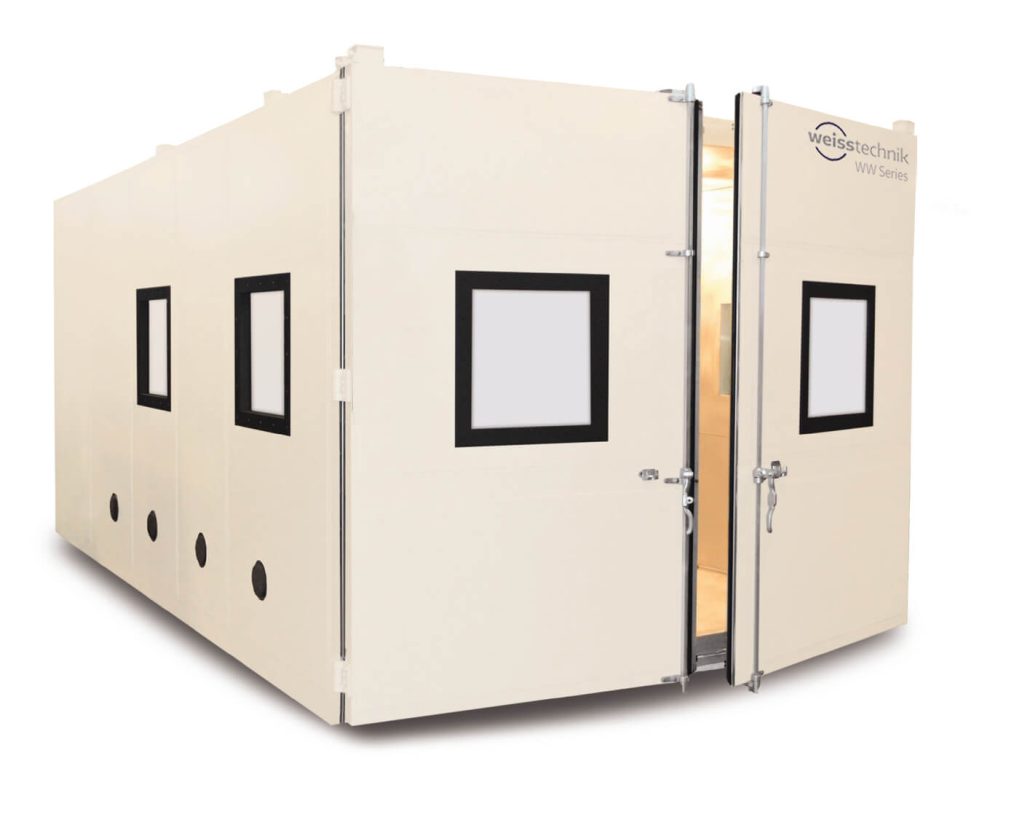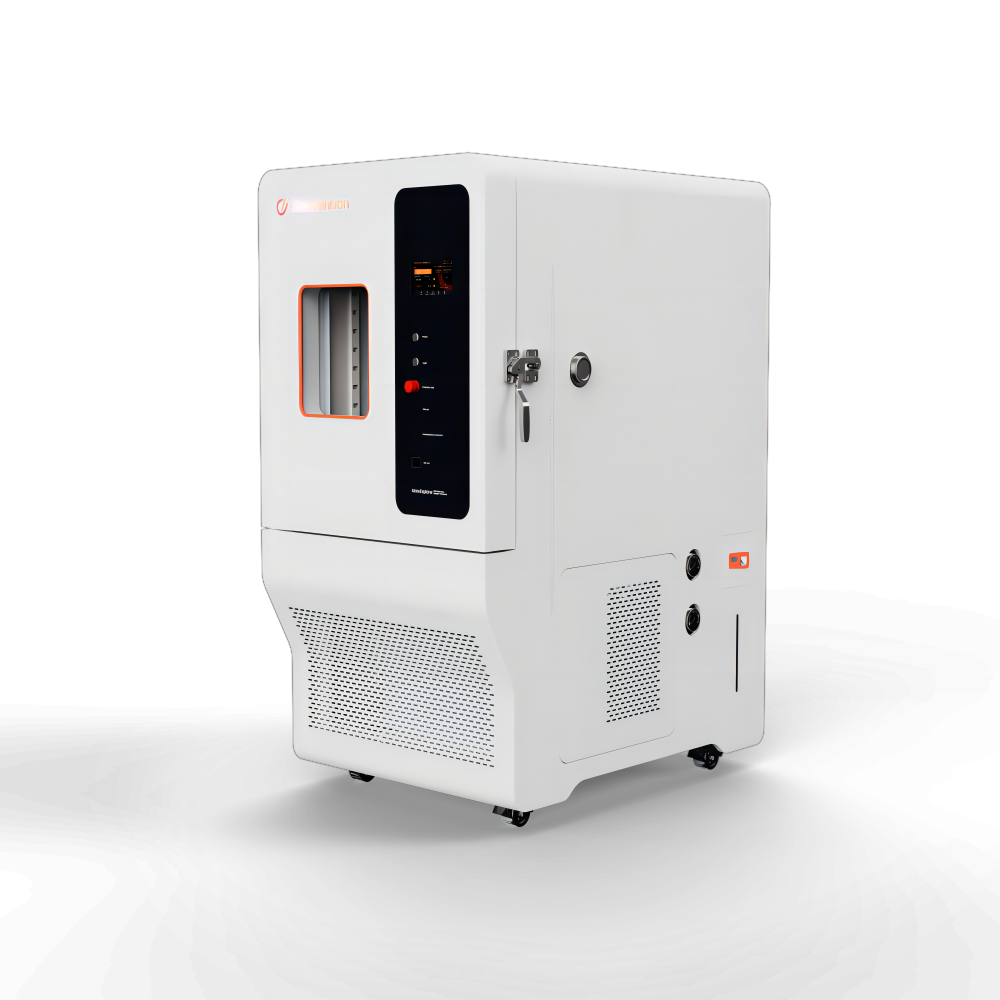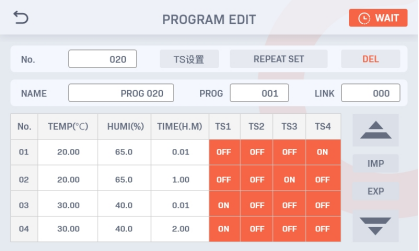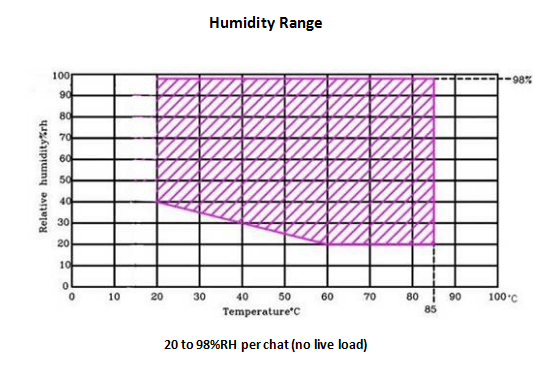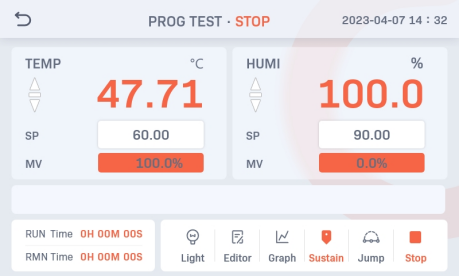Introduction
Ever noticed why your smartphone gets too hot in the summer season? Or wondered why some medicines need to stay cool? These common situations underscore the significance of temperature and humidity chambers. These controlled environments are vital in guaranteeing the quality and reliability of the products we depend on.
From our pocket gadgets to life-saving drugs at home, these chambers subject items to various temperature and humidity conditions, simulating real-world situations. This thorough testing helps uncover potential issues, ensuring products perform as expected, safeguarding consumers, and building trust in the brands we choose.
Understanding temperature and humidity chambers is crucial for manufacturers and those interested in different product manufacturing processes. In this discussion, we’ll explore the chambers’ operation, significance, and how to optimize their use. Let’s dive in.
Understanding Temperature and Humidity Chambers
Definition and Purpose
Meticulously engineered temperature and humidity test chambers precisely control temperature, coldness, and moisture. Essential for environmental testing, they replicate real-world conditions, evaluating product durability across diverse environments.
These TH chambers simulate high and low temperatures to ensure product reliability in extreme conditions. Manufacturers subject products to controlled extremes in these chambers. It helps detect and resolve vulnerabilities proactively before the products reach consumers.
Manufacturers utilize these chambers to:
- Identify potential weaknesses in materials, design, or functionality under specific environmental conditions.
- Assess product performance across different temperature and humidity ranges for consistent operation in diverse environments.
- Predict product lifespan by analyzing material and component reactions to environmental stresses to optimize designs for durability.
- Comply with industry regulations mandating specific environmental testing for product safety and performance.
Features and Components
Temperature and humidity chambers include the following:
Temperature Control System
This system, employing heating and cooling elements, sensors, and controllers, maintains precise testing temperatures – a robust thermostat ensuring consistent hot or cold conditions.
Humidity Control System
Using steam injection and dehumidification units, this mechanism sustains specific moisture levels within the chamber, acting like a personalized cloud maker or dehumidifier tailored for testing products.
Data Acquisition and Monitoring System
Serving as a vigilant eye, this system continuously records temperature and humidity levels during testing, functioning like an integrated weather station for meticulous documentation.
Programmable Controller
The chamber’s brain allows users to set distinct temperature and humidity profiles for varied testing protocols, serving as a recipe book guiding the chamber in creating specific conditions for each test.
Chamber Body
Crafted with specialized insulated materials, the chamber body acts as a thermal barrier, minimizing heat transfer and ensuring constant internal conditions – similar to a well-insulated oven or refrigerator maintaining a stable temperature.
Observation Window (Optional)
Some chambers include a transparent window for visually observing test products without disturbing the internal environment – akin to a peek hole providing insights into ongoing processes.
Safety Features
Equipped with pressure relief valves, over-temperature/humidity alarms, and emergency shut-off mechanisms, chambers prioritize safe operation, preventing potential hazards during testing.
By integrating these components, TH chambers become potent tools for manufacturers across diverse industries, facilitating testing and assurance of product performance and reliability under varied environmental conditions.
Working Mechanism
Temperature and humidity chambers work by precisely managing conditions in an enclosed space.
Temperature Control
- Raising the heat: Utilizing coils, lamps, or steam generators, chambers elevate temperature, with a control system regulating power for stability.
- Bringing down the chill: Refrigerants, like refrigerators, are used in chambers to absorb heat from the air, achieving lower temperatures.
- Airflow for evenness: Continuous air circulation via fans prevents temperature inconsistencies, ensuring uniform conditions.
Humidity Control
Increasing Humidity
- Steam injection: Heated water produces steam to increase humidity.
- Evaporation: Water evaporation, using heat or air circulation, also boosts humidity.
- Ultrasonic mist: High-frequency sound waves remold water into a fine mist that elevates humidity.
Decreasing Humidity
- Condensation: Chilled coils efficaciously condense water vapor, effectively diminishing ambient humidity.
- Desiccants: Moisture-absorbing materials proficiently eliminate excess humidity from the chamber air.
Maintaining Conditions
- Sensors: Small monitors providing real-time data by measuring temperature and humidity.
- Control system: As a brain, it adjusts heating, cooling, humidification, or control dehumidification processes for preciseness by analyzing data.
- Calibration: Frequent sensor calibration ensures the readings are accurate and the test results are reliable.
Importance of Precise Control
Precise temperature and humidity control is paramount for several reasons:
- Accurate results: Minor changes can significantly impact climatic chamber test results, potentially leading to misleading conclusions.
- Consistent testing: Ensures uniform conditions for reliable comparisons and data analysis across tests.
- Material behavior: Different materials react uniquely to varied conditions, and precise control mirrors real-world scenarios, preventing unexpected damage or malfunction.
Types of Temperature and Humidity Chambers
Benchtop Chambers
Compact and Portable
They are ideal for small laboratories or limited spaces, these humidity chambers conveniently fit on workbenches.
Moderate Temperature and Humidity Ranges
Typically suitable for testing electronic components, materials, and small consumer products. They offer a range of temperatures and humidity levels that are adequate for many common testing applications.
Common Applications
Benchtop temp and humidity chambers are widely used in research and development (R&D) for initial testing and feasibility studies, quality control checks for ensuring product consistency, and component-level evaluation during development stages.
Reach-in Chambers
Larger Capacity
Compared to benchtop models, reach-in chambers offer significantly more space, allowing for the testing of larger products or multiple samples simultaneously.
Wider Range of Capabilities
Boasting a broader temperature and humidity range, they are suitable for various testing needs and simulating diverse environmental conditions.
Diverse Applications
Prevalent in research, production, and quality control across industries for testing electronic devices, pharmaceuticals, food items, etc.
Walk-in TH Test Chambers
Largest Size
Walk-in humidity environmental chambers are the most prominent, offering enough space for personnel to enter and directly interact with the testing environment. This allows for the testing of large industrial equipment, and vehicles, and conducting environmental simulations.
Extensive Capabilities
They boast the most extensive temperature and humidity capabilities, suitable for simulating extreme environmental conditions.
Specialized Applications
Walk-in chambers with capabilities to replicate extreme temperature fluctuations and vacuum conditions are crucial for testing aerospace, automotive, and construction materials. These chambers simulate real-world conditions that these products may encounter during usage.
Climate Test Chambers
Specialized Capabilities
Going beyond temperature and humidity control, they have additional features to simulate various environmental conditions. Controlling light, vibration, and air pressure creates a more comprehensive testing environment.
Advanced Simulation
Climate chambers can simulate specific environmental conditions, including those found in various geographic locations or climatic zones. It allows for testing products under conditions they may encounter during transportation, storage, or actual use in specific regions.
Industry-Specific Applications
These enclosures find application in agriculture to mimic ideal growth environments, in pharmaceuticals for assessing drug stability, and in the automotive sector for analyzing vehicle performance in adverse weather conditions.
Special Purpose Test Chambers
Customized Solutions
Designed with specific applications in mind, offering unique features beyond standard chambers.
Industry-Specific Needs
Catering to specialized testing requirements, like salt spray chambers for marine durability and UV chambers for textile colorfastness.
Several instances of specialized chambers include:
- Corrosion Assessment Chambers: Such as Salt Spray Chambers, designed to replicate harsh marine conditions for thorough corrosion resistance evaluation.
- Lightfastness Evaluation Chambers: Include UV Chambers that subject materials to UV radiation for a comprehensive assessment of their resistance to light-induced fading.
- Aerospace Product Testing Chambers: Like Vacuum Chambers that simulate high-altitude environments, ensuring rigorous testing of aerospace products.
Applications of Temperature and Humidity Chambers
Here’s a detailed look at how different sectors utilize these chambers:
-
Electronics Industry
- Testing electronic components: Chambers simulate extreme temperatures and humidity to evaluate the performance and reliability of microchips, circuit boards, and connectors, ensuring functionality under diverse conditions.
- Lifespan and degradation evaluation: Controlled exposure helps estimate the lifespan of electronic devices and identify potential degradation patterns, enabling manufacturers to optimize designs for enhanced durability.
-
Automotive Industry
- Testing vehicle components: Chambers assesses the performance of vehicle components like engines and electrical systems under extreme conditions, ensuring reliable functionality in harsh weather.
- Material integrity assessment: Evaluation of automotive materials like plastics and rubber in varying conditions prevents degradation, warping, or cracking, ensuring long-term vehicle performance and safety.
-
Aerospace Industry
- Simulating flight conditions: Chambers replicate extreme temperature and humidity fluctuations during aircraft operation, assessing the performance of critical components such as avionics and structural materials.
- Condensation and ice testing: Controlled environments for condensation and ice formation are crucial for testing aircraft components, ensuring functionality and safety in diverse weather conditions.
-
Medical Device Industry
- Sterility and functionality testing: Chambers maintain sterile conditions and test medical devices under varied temperature and humidity levels, ensuring sterility and optimal functionality during critical medical procedures.
- Simulating storage and transportation conditions: Temperature and humidity simulations help ensure the safety and effectiveness of medical devices throughout the supply chain.
-
Pharmaceutical Industry
- Drug stability and shelf life testing: Chambers study the stability and shelf life of pharmaceutical drugs under different conditions, ensuring potency and efficacy over their intended shelf life.
- Packaging integrity evaluation: Chambers assess the integrity of pharmaceutical packaging materials, preventing degradation, contamination, or leakage of medication.
-
Food and Beverage Industry
- Food spoilage evaluation: Chambers simulate storage conditions to study food spoilage rates, optimizing packaging materials and storage methods to extend shelf life and minimize waste.
- Packaging performance testing: Assessment of food and beverage packaging materials ensures they maintain product quality and prevent spoilage, contamination, or moisture damage.
-
Consumer Goods Industry
- Product performance and durability testing: Chambers assesses the performance and durability of consumer products like cosmetics and household appliances, ensuring reliability throughout their lifespan.
- Colorfastness and material degradation evaluation: Chambers help assess colorfastness and potential material degradation under varying conditions, aiding manufacturers in selecting quality materials and processes.
These examples showcase the versatility and critical role of temperature and humidity chambers in ensuring product quality, reliability, and safety across diverse industries.
Comparative Analysis with Other Testing Methods
Stability temperature and humidity chambers play a crucial role in environmental testing, but they’re just one option among many. To choose the best approach for your needs, it’s essential to weigh their pros and cons against traditional testing methods.
Compared with Traditional Testing
Before the widespread use of temperature and humidity-controlled cabinets, traditional methods were the norm. While they still have value in certain situations, they often have limitations.
Advantages of Temperature and Humidity Test Chambers
- Controlled Environment:
controlled humidity chambers offer precise control for consistent and repeatable testing, eliminating external factors for reliable results
- Wider Range: Chambers can simulate a broader range of temperature and humidity levels, suitable for testing products in diverse environments.
- Accelerated Testing: Chambers speed up testing by exposing products to extreme conditions briefly, efficiently identifying weaknesses, and predicting long-term performance.
- Data Acquisition: Modern TH chambers with sensors and data logging provide continuous monitoring, essential for analyzing trends or issues during testing.
Disadvantages of Traditional Testing
- Limited Control: Traditional methods struggle to control environmental factors precisely, leading to inconsistent conditions and potentially unreliable results.
- Limited Range: Traditional methods may not replicate a wide range of conditions, making them unsuitable for testing products intended for extreme environments.
- Time-Consuming: Traditional methods often require longer testing times, increasing costs and causing delays compared to chambers that provide stress in a shorter period.
- Limited Data: Traditional methods may lack the data acquisition capabilities of chambers, making it challenging to track changes and identify issues during testing.
In summary, temperature and humidity chambers excel in control, range, efficiency, and data acquisition compared to traditional methods. However, the choice depends on the specific product, testing requirements, and budget constraints.
How to Choose the Right Chamber
Selecting the perfect Temperature and Humidity (TH) chamber demands a thoughtful analysis of various factors to ensure alignment with your testing needs and budget. Here’s a concise breakdown for assessing manufacturers and their TH chambers:
Temperature and Humidity Range
- Define the product’s operational, storage, or transportation temperatures.
- Determine the required humidity range throughout the product’s lifecycle.
- Ensure the chamber has a buffer beyond your range for testing efficiency and future needs.
Chamber Volume and Size
- Choose a temperature and humidity test chamber with internal volume accommodating your test product(s) comfortably.
- Consider available space in your testing facility and select dimensions for proper placement.
Control Accuracy and Uniformity
- Evaluate the chamber’s accuracy in maintaining desired temperature and humidity levels.
- Assess uniformity in temperature and humidity throughout the internal volume.
Additional Features and Functionality
- Consider features like programmable test cycles and data logging for effective recording and analysis.
- Evaluate safety features such as alarms, cut-offs, and door safety interlocks.
- Prioritize user-friendly controls and clear instructions for ease of operation and maintenance.
Manufacturer Reputation and Service
- Research the manufacturer’s industry reputation, considering customer reviews, product quality, and industry recognition.
- Evaluate the commitment to after-sales support, including technical assistance, warranty coverage, and spare parts availability.
Manufacturers Recommendations
To evaluate a manufacturer consider:
Product Quality
- Reputation: Check for a solid track record and industry reputation.
- Certifications: Look for ISO 9001 certification for quality management.
- Warranty: Consider warranty length and coverage.
- Technical Specifications: Compare temperature, humidity range, uniformity, and control accuracy.
Service Level
- Customer Support: Assess responsiveness and channels for customer support.
- Service Network: Check for availability and proximity of service technicians.
- Training and Support: Consider offering training programs for proper operation and maintenance.
User reviews offer insights but verify sources and be cautious of biases. The right manufacturer depends on your needs, budget, and desired features. Thorough research ensures an informed decision for reliable performance.
Top Manufacturers
Here are reputable temperature and humidity test chamber manufacturers:
- Bionics Scientific (India)
Known for reliable, customizable chambers for research and industry.
- Darwin Chambers (US)
Offers benchtop, reach-in, and walk-in models. Focuses on energy efficiency and user-friendliness.
- ESPEC Corp. (Japan)
A global leader in environmental testing equipment. Broad portfolio with advanced features and global support.
- GE Healthcare (US)
Provides high-precision chambers for pharmaceutical and medical device industries.
- ChiuVention (China)
Designed in Germany, made in China, sold and serviced in 42 countries around the world.
- Herculite Environmental Solutions (US)
Specializes in custom-built chambers for unique testing needs.Thrives in challenging environmental conditions.
- Sanyo (Japan)
Offers reliable and durable chambers for various industries.
- Thermo Fisher Scientific (US)
Leading scientific instrument provider. Offers advanced chambers with comprehensive service packages.
For climate chamber prices, you can directly send them an email.
Environmental Testing Standards
International testing standards and governing procedures for environmental tests like temperature and humidity, play a vital role. They maintain consistency, reliability, and comparability of results across various labs and manufacturers.
Key Standards
- ISO (International Organization for Standardization): ISO 16750 sets the requirements for environmental test chamber design, performance, and calibration.
- IEC (International Electrotechnical Commission): IEC 60068 covers a range of environmental testing methods, including temperature, humidity, vibration, and corrosion.
- ASTM (American Society for Testing and Materials): ASTM International provides standards like ASTM D638, focusing on determining the tensile properties of plastics in temperature and humidity testing.
Why Compliance Matters?
Adhering to these standards is critical for various reasons:
- Market Access: Many countries and regulatory bodies demand compliance with specific standards for products to enter the market.
- Safety and Quality Assurance: Following established standards demonstrates a commitment to product safety and quality, building consumer trust.
- Fair Comparison: Standardized testing enables a fair comparison of product performance across different manufacturers and brands.
- Efficiency Benefits: Compliance streamlines testing processes, potentially reducing costs and time linked to custom testing procedures.
By understanding and adhering to these international testing standards, industries ensure product quality, safety, and efficiency.
Safety Measures
Operational Safety Guidelines
- All constant climate chamber operators must undergo comprehensive training covering the chamber’s functionalities, safety features, and emergency procedures.
- Use appropriate PPE like gloves and eye protection when handling materials or performing maintenance inside the chamber.
- Regularly inspect power cords and connections for damage.
- Do not operate the chamber with faulty electrical components.
- Keep the chamber area clear of flammable materials.
- Clearly label all materials inside the chamber, especially hazardous or volatile substances.
Emergency Protocols
- Follow established protocols to safely shut down the chamber and secure test items during a power outage.
- Respond promptly to alarms indicating deviations from set levels.
- Investigate and take corrective measures.
- Cease operation immediately and contact qualified personnel if the chamber malfunctions.
- Contain spills promptly.
- Utilize proper personal protection and disposal procedures for hazardous materials.
Precautions During Emergencies
- Follow established procedures during a fire or other emergencies.
- Avoid opening the chamber during emergencies unless instructed by emergency personnel.
- If exposed to extreme conditions or hazardous materials, seek medical attention immediately.
Common Challenges in Environmental Testing
Common Challenges
In environmental testing, numerous challenges can impact its efficiency, accuracy, and cost-effectiveness. Here’s a concise breakdown of the commonly encountered difficulties:
Chamber Selection and Configuration
Choosing the right constant temperature and humidity chamber size, temperature range, and humidity control capabilities is pivotal.
Inappropriate chamber selection can limit testing scope or yield inaccurate results.
Maintaining Stable Conditions
Precise temperature and humidity control is crucial for reliable testing.
Chamber leaks, insulation issues, and sensor malfunctions can cause fluctuations, affecting data integrity.
Test Sample Preparation and Placement
Inadequate sample preparation and incorrect positioning can influence results.
Uneven airflow within the chamber can lead to inconsistent exposure across samples.
Data Acquisition and Analysis
Well-maintained equipment and analytical skills are essential for accurate recording and interpretation.
Errors in data collection or misinterpretations can result in flawed conclusions.
Cost and Time Constraints
Equipment and operational costs for environmental testing can be substantial.
Lengthy testing cycles may impede product development timelines.
Solutions and Strategies
Consult with Experienced Testing Professionals
Seek guidance from experts for optimal chamber selection, configuration, and operation.
Invest in High-Quality Equipment
Reliable temperature and humidity-controlled boxes with precise control systems and well-maintained sensors minimize the risk of fluctuations.
Implement Standardized Testing Procedures
Established protocols ensure consistent sample preparation, placement, and data collection.
Utilize Data Analysis Software
Specialized software streamlines data acquisition, analysis, and interpretation, reducing the risk of human error.
Explore Cost-Saving Alternatives
Consider outsourcing specific testing needs or utilizing shared testing facilities to optimize resource allocation.
By addressing these challenges through informed planning, meticulous execution, and continuous improvement, manufacturers can ensure effective and reliable environmental testing, leading to the development of robust and high-quality products.
Maintenance and Calibration
Regular Maintenance
To uphold the optimal performance and longevity of your temperature and humidity chamber, routine maintenance is imperative. Follow these steps:
- Cleaning: Regularly clean the chamber interior to remove dust and debris. Monthly cleaning is generally recommended, though actual frequency depends on usage and environment.
- Filter Replacement: Replace air and water filters according to the manufacturer’s recommendations or when signs of clogging appear. Clogged filters can impede temperature and humidity control.
- Door Seal Inspection: Regularly inspect the door seal for wear, tears, or gaps. A damaged seal can compromise chamber performance and accuracy.
- Sensor Cleaning: Use manufacturer-recommended methods to clean temperature and humidity sensors. Contaminated sensors can provide inaccurate readings.
- Visual Inspection: Routinely inspect the chamber interior and exterior for damage, leaks, or loose components. Promptly address any issues.
Importance of Routine Maintenance
Routine maintenance provides multiple benefits:
- Ensures Accuracy: Maintaining optimal conditions ensures confidence in the accuracy and reliability of test results.
- Minimizes Downtime: Proactive maintenance prevents unexpected breakdowns, reducing downtime and ensuring efficient testing operations.
- Extends Lifespan: Proper maintenance significantly contributes to extending the lifespan of your chamber, maximizing return on investment.
Calibration Procedures
Calibration verifies and adjusts the accuracy of temperature and humidity sensors against a traceable reference standard. Follow these steps:
- Frequency: Calibration frequency depends on usage, industry standards, and internal quality control. Typically, it is recommended annually.
- More Frequent Calibration: For intensive or critical applications, consider more frequent calibration (e.g., biannually or quarterly).
Calibration Steps:
- Schedule Calibration: Contact a qualified, nationally accredited calibration service provider.
- Prepare the Chamber: Follow manufacturer instructions for calibration preparation, including specific temperature and humidity settings and stabilization times.
- Calibration Process: The service provider will use specialized equipment to compare chamber readings with a traceable reference standard, making adjustments for accuracy.
- Calibration Certificate: Upon completion, receive a calibration certificate detailing procedures, reference standards, and any adjustments made.
Future of Temperature and Humidity Control Chambers
In the dynamic field of temperature and humidity chambers, technology and demand drive constant evolution.
1. Cutting-edge Technologies
Advanced Materials: Ongoing research aims to enhance materials with superior thermal and moisture resistance, expanding testing capabilities. This allows for precise testing of products in extreme conditions, such as electronics for space or military applications.
Integration of IoT and Sensors: The Internet of Things (IoT) is revolutionizing chamber operations by seamlessly incorporating various sensors.
- Enhanced Control: Real-time data ensures accurate and consistent testing conditions.
- Optimized Testing Processes: Data analysis streamlines procedures, reducing time-to-completion.
Machine Learning and Artificial Intelligence (AI): AI is transforming chamber operations by predicting maintenance needs, optimizing testing parameters, and improving overall efficiency.
2. Emerging Trends
Focus on Energy Efficiency: Sustainability is a growing concern, leading to the development of energy-efficient designs and advanced insulation techniques.
- Sustainable Designs: Manufacturers focus on energy-efficient components to reduce power consumption and operating costs.
- Advanced Insulation Techniques: Improved materials minimize heat transfer, decreasing energy requirements.
Customization and Modularity: Flexibility drives trends toward modular chambers and configurable testing environments.
- Modular Chambers: Interchangeable components provide cost-effective, customizable testing solutions.
- Configurable Testing Environments: Adjustable features allow precise replication of real-world conditions.
Remote Monitoring and Control: Cloud-based platforms enable remote access, fostering collaboration and enhancing process management.
3. Industry 4.0 and Smart Manufacturing Integration
The Fourth Industrial Revolution emphasizes automation, data-driven decisions, and interconnectivity. Temperature and humidity chambers play a vital role by seamlessly integrating with smart manufacturing systems.
Seamless Integration with Automation Systems: Chambers connect with automated production lines, allowing:
- Synchronized Testing: Products automatically move to chambers at specific production stages for efficient testing.
- Real-time Quality Control: Data from chambers feeds into production line control systems, enabling real-time adjustments.
Data-driven Insights and Decision Making: The data generated by sensors and chambers offers insights for optimizing production processes and improving overall product quality.
Energy Efficiency
In today’s environmentally aware world, focusing on energy efficiency is vital for all industries, including temperature and humidity chambers. Cutting down on energy use not only lowers operational costs but also lessens the impact on the environment. This section explores why energy efficiency matters in chamber operations and discusses practical strategies and technologies to enhance it.
Significance in Cost Reduction
Temperature and humidity chambers can be hefty energy consumers, especially during continuous or extended testing periods. High energy use results in increased operational costs, affecting a company’s finances. Adopting energy-efficient practices can lead to substantial savings through:
- Reduced Electricity Bills: Lowering energy consumption translates into significant cost reductions on electricity bills.
- Extended Equipment Lifespan: Efficient operation reduces thermal stress on components, extending chamber lifespan and minimizing replacement costs.
- Improved Sustainability Image: Demonstrating a commitment to energy efficiency enhances a company’s sustainability image, potentially attracting environmentally conscious customers and investors.
Strategies and Technologies for Improvement
Several strategies and technologies can enhance the energy efficiency of temperature and humidity chambers:
Strategies
- Optimizing Test Parameters: Set and stick to optimal temperature and humidity settings for specific tests to minimize the energy required.
- Minimizing Idle Time: Power down chambers when not in use to significantly reduce energy consumption. Timers or automated shut-off features can ensure chambers operate only when needed.
- Regular Maintenance: Regularly clean coils and filters to ensure optimal performance, minimizing energy usage.
Technologies
- Energy-Efficient Components: Use components like variable-speed drives (VSDs) for fans and compressors to significantly reduce energy consumption. VSDs adjust motor speeds based on demand, minimizing energy waste.
- Improved Insulation: Utilize high-quality insulation materials to minimize heat transfer, reducing the energy needed to maintain desired temperatures.
- Heat Recovery Systems: Advanced chambers include heat recovery systems that capture waste heat and use it for preheating incoming air, reducing the need for energy from primary sources.
By implementing these strategies and technologies, companies can notably improve the energy efficiency of their temperature and humidity chambers, leading to cost savings, reduced environmental impact, and a more sustainable operation.
Research and Development
1. Progress in Environmental Testing
Researchers are continuously enhancing the capabilities of temperature and humidity chambers. This involves pushing the limits of environmental conditions, including extreme temperatures and humidity levels, and integrating factors like vibration, radiation, and altitude simulation.
Material and Component Innovations: Material scientists are creating materials with improved thermal conductivity, moisture resistance, and durability. These advancements result in chambers with:
- Improved Efficiency: New materials enhance thermal insulation and reduce energy consumption.
- Extended Durability: Chambers built with advanced materials have a longer lifespan and require less maintenance.
- Expanded Testing Range: Some materials withstand extreme conditions, enabling chambers to operate in previously inaccessible ranges.
Standardization and Regulations: Collaboration between industry and government bodies ensures consistent, reliable, and safe testing procedures, driving the evolution of environmental testing.
2. Industry-Academia Collaboration
Collaboration between industries and academia is pivotal for innovation in environmental testing:
- Joint Research Projects: Universities and research institutions team up with industry partners on specific R&D projects, combining expertise and resources to solve complex challenges.
- Student Internships and Research Opportunities: Universities offer students internships and research opportunities in industry settings, exposing them to real-world issues and cultivating a skilled workforce.
- Knowledge Sharing and Technology Transfer: Regular communication between academia and industry facilitates the translation of cutting-edge research into practical applications, readily adopted by industry players.
The synergy between industry and academia is vital for advancing environmental testing technologies. Together, they address challenges, explore new frontiers, and contribute to developing efficient, reliable, and sustainable testing solutions.
Regulatory Compliance and Certification
Regulatory Compliance
Regulations governing product safety, performance, and environmental impact vary by industry and region. Industries often require testing products in controlled environments mimicking real-world conditions. Temperature and humidity chambers are vital for regulatory compliance, aiding manufacturers to:
- Conduct Rigorous Testing: Chambers create controlled environments for testing products, ensuring they meet specific regulatory requirements for performance and safety under different conditions.
- Demonstrate Compliance: Accredited testing facilities and documented procedures help manufacturers generate test reports, crucial for proving compliance with regulations, obtaining product approvals, and accessing markets.
Certifications for Product Quality
Certifications from independent organizations enhance product credibility and trust. Certifications involve stringent testing, including temperature and humidity chamber tests, ensuring products meet quality standards.
- Enhanced Reputation: Certifications signify quality, instilling consumer confidence and strengthening brand reputation.
- Market Access and Growth: Certifications meeting specific country or industry requirements open doors to new markets, facilitating business expansion.
- Reduced Liability Risk: Certifications demonstrate due diligence in ensuring product safety and performance, mitigating the risk of liability claims and associated repercussions.
Examples of Requirements and Certifications
- Medical Devices: The International Electrotechnical Commission (IEC) standards require testing under specific temperature and humidity conditions for medical device safety and performance.
- Automotive Industry: The International Organization for Standardization (ISO) sets standards for testing automotive components under diverse environmental conditions, a prerequisite for selling vehicles in specific markets.
- Electronics Industry: The RoHS directive in the EU restricts hazardous substances in electronic products, often requiring temperature and humidity testing for compliance.
Manufacturers staying informed on regulations and securing relevant certifications utilize temperature and humidity chambers to meet standards, ensuring products are of high quality and reliability. This fosters trust and success in the marketplace.
The Role of Data Analytics
Temperature and humidity chambers generate extensive data during testing, capturing vital information about environmental parameters. Yet, raw data must undergo analysis for valuable insights. Enter data analytics.
Utilization for Interpreting Test Results
Data analytics enables engineers and researchers to:
- Identify Trends and Patterns: Statistical analysis uncovers significant trends and correlations between environmental conditions and product performance.
- Detect Anomalies and Deviations: Algorithms efficiently identify deviations, allowing early detection of potential issues and timely corrective actions.
- Visualize Data: Transform complex data into clear charts and graphs, facilitating communication and collaboration.
Benefits of Data-Driven Decision-Making
Manufacturers leverage data analytics for:
- Improved Product Design: Insights from testing inform design decisions, and optimizing products for enhanced performance and durability.
- Optimized Testing Processes: Identify inefficiencies, optimizing parameters for faster testing cycles and reduced costs.
- Enhanced Quality Control: Historical data establishes benchmarks, enabling proactive quality control measures and preventing defective products.
- Predictive Maintenance: Advanced analytics predict equipment failures, allowing proactive maintenance and minimizing downtime.
Data analytics is pivotal in unlocking temperature and humidity chambers’ potential. Extracting insights leads to a deeper understanding of product behavior, optimized processes, and informed decisions, ultimately enhancing product quality, reducing costs, and improving overall efficiency.
Environmental Impact
Discussion on Testing Processes’ Environmental Footprint
While temperature and humidity chambers are role in ensuring product quality and reliability, it’s important to acknowledge their potential environmental impact. Here are some key considerations:
- Energy Consumption: Maintaining specific temperature and humidity levels within chambers requires significant energy consumption, contributing to greenhouse gas emissions and placing a strain on power grids.
- Refrigerants: Traditional chambers often utilize refrigerants that, if not properly managed, can leak into the atmosphere and contribute to ozone depletion and global warming.
- Material Use: The manufacturing process and components used in chambers themselves can have environmental implications, including the extraction of raw materials, manufacturing processes, and potential end-of-life disposal challenges.
Strategies for Minimizing Environmental Impact
Fortunately, various strategies can be implemented to mitigate the environmental impact of temperature and humidity chambers:
Energy Efficiency
- Utilizing chambers with energy-efficient features, such as improved insulation and variable speed drives, can significantly reduce overall energy consumption.
- Implementing renewable energy sources, like solar panels, to power chambers can further minimize their environmental footprint.
Sustainable Refrigerant Choices
- Choosing constant temperature chambers that utilize environmentally friendly refrigerants with lower global warming potential (GWP) is crucial.
- Ensuring proper maintenance and leak detection systems are in place to prevent refrigerant escapes and their associated environmental consequences.
Sustainable Material Selection
- Selecting chambers constructed with recycled or recyclable materials can minimize the environmental impact associated with raw material extraction and end-of-life disposal.
- Supporting manufacturers who prioritize sustainable practices throughout the chamber lifecycle, from material sourcing to manufacturing processes.
Optimizing Chamber Usage
- Implementing efficient testing protocols that minimize unnecessary chamber operation times can contribute to reduced energy consumption.
- Sharing chamber resources among different departments or collaborating with other companies can further optimize their utilization and minimize the overall environmental footprint.
By adopting these strategies, manufacturers and testing facilities can significantly reduce the environmental impact of temperature and humidity chambers, ensuring responsible and sustainable testing practices while upholding product quality and reliability.
Conclusion
Summary
This guide explores the world of temperature and humidity regulation chambers, emphasizing their crucial role in product development. Key points covered include:
- Product Reliability and Safety:
Humidity environmental chambers simulate various conditions to identify and address product weaknesses, enhancing performance and reducing failure risks.
- Applications Across Industries: Used in electronics, pharmaceuticals, aerospace, and automotive industries, ensuring product quality and compliance with standards.
- Selecting the Right Chamber: Considerations like chamber size, temperature/humidity range, and budget are crucial for meeting specific testing needs.
- Adherence to Testing Standards: Compliance with international standards ensures consistent and reliable results, fostering market access and consumer trust.
- Best Practices for Operation and Maintenance: Proper maintenance and calibration are vital for accurate and reliable testing outcomes.
- Future Advancements and Trends: Emerging technologies (AI, IoT), focus on energy efficiency, and Industry 4.0 integration promise more sophisticated testing solutions.
Temperature and humidity chambers are pivotal for product development, ensuring:
- Vulnerability Identification: Proactively addressing weaknesses reduces the risk of failures in the market.
- Guaranteed Product Performance: Rigorous testing assures that products function as intended and remain safe in various environments.
- Building Trust and Reputation: Consistent reliability and safety adherence build consumer trust and solidify brand reputation.
In short, investing in these chambers goes beyond regulations; it prioritizes product safety, consumer well-being, and building a trustworthy brand.
